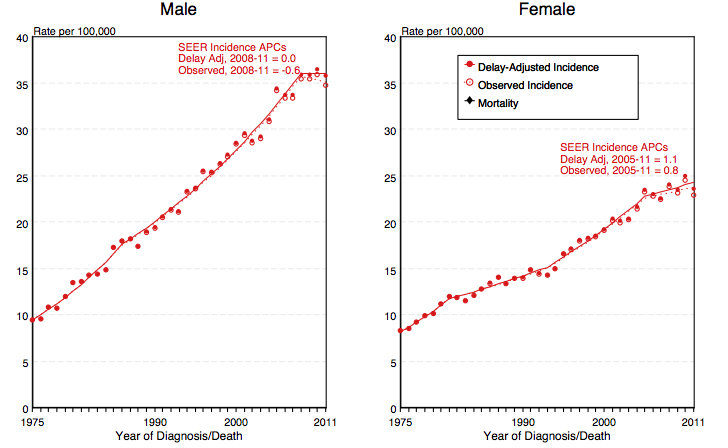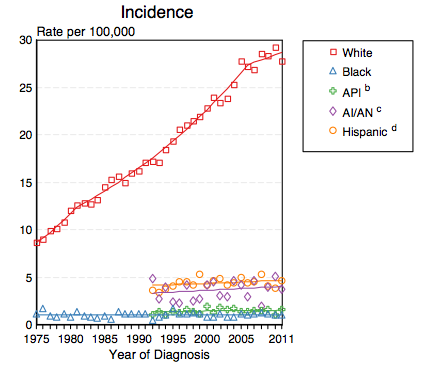Melanoma epidemiology and demographics
|
Melanoma Microchapters |
|
Diagnosis |
|---|
|
Treatment |
|
Case Studies |
|
Melanoma epidemiology and demographics On the Web |
|
American Roentgen Ray Society Images of Melanoma epidemiology and demographics |
|
Risk calculators and risk factors for Melanoma epidemiology and demographics |
Editor-In-Chief: C. Michael Gibson, M.S., M.D. [1]; Associate Editor(s)-in-Chief: Rim Halaby, M.D. [2]
Overview
Around 132,000 new cases of melanoma are diagnosed worldwide each year, and the number is estimated to increase by an additional 4,500 cases with a 10% decrement in the ozone levels.[1] The incidence of melanoma and other skin cancers is on the rise due to the increased exposure to sun and the increased rate of sunburns.[1] It is more common in caucasian populations and males.[2] According to the WHO Report about 48,000 melanoma related deaths occur worldwide per annum.[3] In the United States, the age-adjusted prevalence of melanoma is 187 per 100,000 in 2011.[2]
Epidemiology and Demographics
Prevalence
- In the United States, the age-adjusted prevalence of melanoma is 187 per 100,000 in 2011.[2]
Incidence
- The delay-adjusted incidence of melanoma in 2011 was estimated to be 23.21 per 100,000 persons in the United States.[2]
- In 2011, the age-adjusted incidence of melanoma was 22.74 per 100,000 persons in the United States.[2]
Age
- While the overall age-adjusted incidence of melanoma in the United States between 2007 and 2011 is 21.3 per 100,000, the age-adjusted incidence of melanoma by age category is:[2]
- Under 65 years: 12.6 per 100,000
- 65 and over: 81.1 per 100,000
- Shown below is an image depicting the delay-adjusted incidence and observed incidence of melanoma by age and gender in the United States between 1975 and 2011. These graphs are adapted from SEER: The Surveillance, Epidemiology, and End Results Program of the National Cancer Institute.[2]
Gender
- In the United States, the age-adjusted prevalence of melanoma by gender in 2011 is:[2]
- In males: 213.2 per 100,000
- In females: 170.1 per 100,000
- In the United States, the delay-adjusted incidence of melanoma by gender in 2011 is:[2]
- In males: 29.51 per 100,000 persons
- In females: 18.73 per 100,000 persons
- In the United States, the age-adjusted incidence of melanoma by gender on 2011 is:[2]
- In males: 28.92 per 100,000 persons
- In females: 18.35 per 100,000 persons
- Shown below is an image depicting the delay-adjusted incidence and observed incidence of melanoma by gender in the United States between 1975 and 2011. These graphs are adapted from SEER: The Surveillance, Epidemiology, and End Results Program of the National Cancer Institute.[2]
Race
- Shown below is a table depicting the age-adjusted prevalence of melanoma by race in 2011 in the United States.[2]
| All Races | White | Black | Asian/Pacific Islander | Hispanic | |
| Age-adjusted prevalence | 187 per 100,000 | 234.5 per 100,000 | 7.5 per 100,000 | 11.1 per 100,000 | 37.9 per 100,000 |
- Shown below is an image depicting the incidence of melanoma by race in the United States between 1975 and 2011.[2]
API: Asian/Pacific Islander; AI/AN: American Indian/ Alaska Native
References
- ↑ 1.0 1.1 Ultraviolet radiation and the INTERSUN Programme. WHO. Accessed on June 16, 2014
- ↑ 2.00 2.01 2.02 2.03 2.04 2.05 2.06 2.07 2.08 2.09 2.10 2.11 2.12 Howlader N, Noone AM, Krapcho M, Garshell J, Miller D, Altekruse SF, Kosary CL, Yu M, Ruhl J, Tatalovich Z,Mariotto A, Lewis DR, Chen HS, Feuer EJ, Cronin KA (eds). SEER Cancer Statistics Review, 1975-2011, National Cancer Institute. Bethesda, MD, http://seer.cancer.gov/csr/1975_2011/, based on November 2013 SEER data submission, posted to the SEER web site, April 2014.
- ↑ Lucas, R. Global Burden of Disease of Solar Ultraviolet Radiation, Environmental Burden of Disease Series, July 25, 2006; No. 13. News release, World Health Organization


